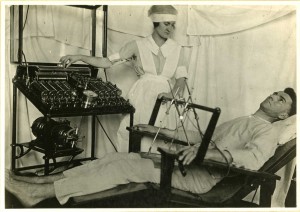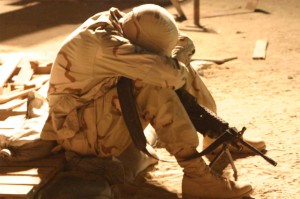By Jared Weber – 12th Grade, Central Catholic High School
Walking into Soldiers and Sailors memorial, I didn’t know what to expect. I had preconceptions that the crowd would be mostly young adults interested in what a peer, Alexis Werner, had accomplished. I was greeted by a much different but more impactful scene. The hall turned movie theater was filled with people in and involved with her documentary, “Our Way Home”, but also local veterans.
The rise of Post-Traumatic Stress Disorder is an important one. Post-Traumatic Stress Disorder in veterans can be denied as unresolved trauma from war that affects the mental stability of veterans in the present. Common symptoms are mood swings, disruption of normal behavior and sleep, as well as serious negative physiological effects such as depression.
In America, the earliest diagnoses of PTSD occurred after the Civil War. These cases of mental illness were classified as “soldiers-heart”, “nostalgia”, or simple insanity. The treatment for these cases was very poor. Often, soldiers diagnosed with these were put in rail cars headed to their hometown. From there, they were left on their own. This group of hapless veterans led to the first show of support for veterans by the American people. The first military hospital for the insane was established. This was an important step but clearly inadequate treatment for those who kept the Union intact.
The next development came after World War I, these soldiers were diagnosed with “shell shock”. The horrors of the trenches during The Great War affected many of the young men who fought in them. At the beginning, especially in the British army, many soldiers were diagnosed with this and removed from combat for only a few days. However, as the war continued and able bodied men grew fewer, the British diagnosis of shell shock was banned and even censored in medical journals. This public shunning of people who were mentally affected by their battles only worsened and implanted a negative connotation of mental illness and especially Post Traumatic Stress Disorder.
The next major war, World War II, brought more developments in terms of the mental health of soldiers. Combat Stress Disorder was a common diagnosis and was often attributed to soldiers fatigue and low morale. Full time psychiatrists were employed but the full scope of the mental toll that war could take on soldiers was still not fully recognized. Most were still under-treated and while CSD is a present diagnosis and one that does not explicitly mean PTSD, it is often a predictor of it and should not be taken lightly, even though it has been in our past treatment of soldiers.
PTSD has really came to the forefront of care for soldiers after many young men returned to the United States after the Vietnam War and the wars in Iraq and Afghanistan. Today, 20% of veterans from the Iraq and Afghanistan wars, and 30% from the Vietnam War have been diagnosed with PTSD. These numbers are staggering. With the increased diagnoses of PTSD in our nation’s heroes, the perception of the mental health disease has begun to shift. More people understand that PTSD is a real, serious, ailment which affects many of our veterans. This is a positive change in public opinion, however much work is still needed.
The documentary really focused on the need for veterans to get help. It covered much of how the public’s perception of the disease negatively affected these men and women. However, I thought that the more important issue that was emphasized was that veterans needed to feel comfortable in their environment to seek vital help. This is a difficult thing for civilians to do but it is telling of what is needed. People who have not served cannot understand what someone who has been in the military has been through. This makes creating a safe feeling for these men affected by the disease important. They need to be able to talk and relate with other people in similar situations.
I spoke with one veteran who preferred to remain anonymous. He was a Vietnam War veteran who has lived in Pittsburgh for many years. He said that “…interaction with the community and family is important,” for veterans to get back on their feet and involved in everyday life again after the war. On a positive note he also said that Pittsburgh’s VA hospital is one of the best. He said that it can get overwhelmed by many requests but overall it treats its veterans with a huge outpouring of love and support. Another positive point about Pittsburgh’s affairs with veterans is a statement by Mayor Bill Peduto. He was in attendance for the beginning of the event and gave a brief speech. His point that stood out the most was Pittsburgh’s fight with veteran homelessness. When he took office there were 487 known homeless veterans and now there are only 59, a remarkable improvement.
A documentary and discussion such as this can’t help but make you think. War veterans do a remarkable service to us everyday citizens. PTSD is a part of many of their lives and it cannot be ignored any longer. As communities we must welcome veterans back into our arms with love and understanding. Alexis Werner, her documentary “Our Way Home”, and her organization Seeds of Hope for Veterans, along with many other veteran organizations are only part of the process.
 Emilio Jared Weber is a senior at Central Catholic High School. He lives in the Bloomfield neighborhood of the city and loves being in Pittsburgh. He’s the captain of the Ultimate Frisbee team and editor of the newspaper at school. Jared loves listening to records, hanging with friends, and playing frisbee.
Emilio Jared Weber is a senior at Central Catholic High School. He lives in the Bloomfield neighborhood of the city and loves being in Pittsburgh. He’s the captain of the Ultimate Frisbee team and editor of the newspaper at school. Jared loves listening to records, hanging with friends, and playing frisbee.
Leave a Comment